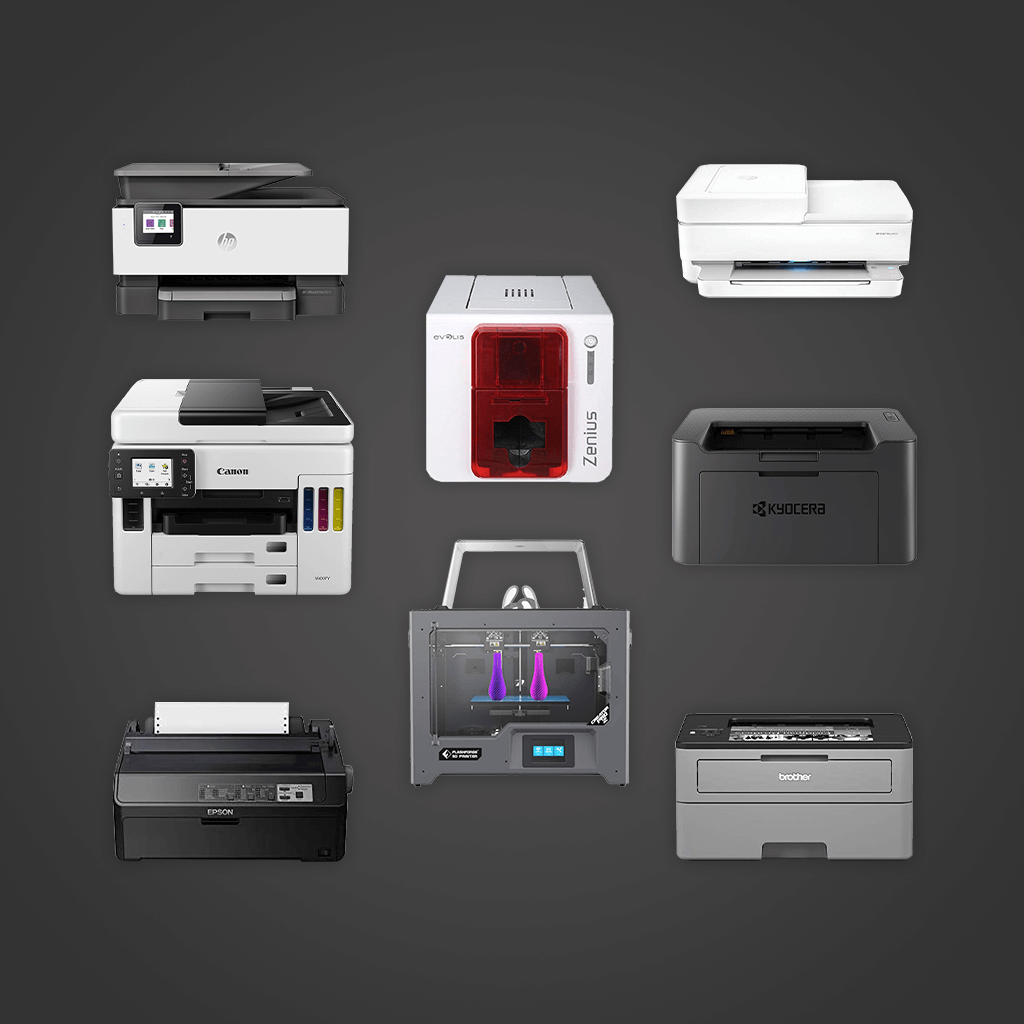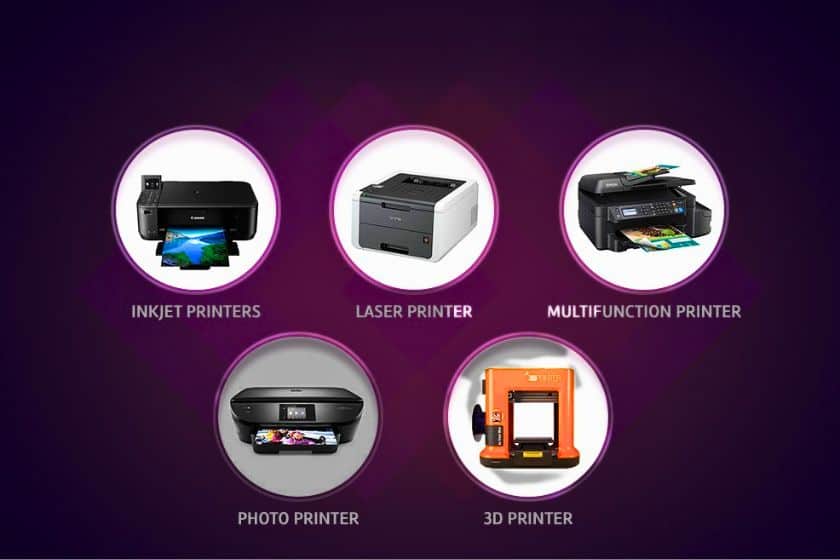Understanding The Printer Realm: A Guide to The 4 Different Types of Printers
Introduction
When it comes to the technology realm, printers still hold a central place both in the corporate world and our homes. Despite the rapidly growing digital era, physical documents are not yet a thing of the past. Whether it's printing a scenic photo, an office report, or a restaurant receipt, different printers serve various purposes. This guide will unpack the 4 main types of printers, explaining how each works, its use, and the person it best suits. We'll also help you understand how to make the best selection for your specific printing needs.
What Are the 4 Main Types of Printers?
In today's digital age, the printer landscape features a diverse array of technologies, each serving unique functions to cater to varying needs, whether in a business setting or home environment. Among these variations, four printer types remain prevalent due to their distinct attributes and uses: Laser, Inkjet, Solid Ink, and Thermal printers. Here is a more in-depth spotlight on each of these printer types:
1. Laser Printers: This printing technology relies on the combination of static electricity and heat, which bonds powdered ink (toner) onto paper surfaces. Laser printers are known for their top-tier print quality, swift print speed and cost efficiency on a per-page basis, making them a top choice for office settings and businesses which require high-volume printing.
2. Inkjet Printers: These printers earn their name from the core functionality: they squirt tiny droplets of liquid ink onto the paper surface. The end products can range from high detail document copies, vivid graphics to life-like photos prints, making this printer type highly versatile.
3. Solid Ink Printers: Unlike the other printer types, Solid Ink Printers adopt an alternative approach by using solid ink in stick form instead of liquid ink or toner cartridges. The ingenuity of this technology lies in its process: the solid ink is melted and applied to a drum, which subsequently transfers the ink onto paper. They stand out for their superior color vibrancy, waste reduction, and compact dimensions.
4. Thermal Printers: Unique in their mechanism, Thermal Printers print by utilizing heat to create characters or images on special thermal-sensitive paper. The highlight of this printer type resides in its cost-effectiveness due the absence of ink or toner requirements.
In summary, these four printer types each possess distinctive features and uses. Laser printers are renowned for their speed and cost performance in high volume printing, Inkjet printers compliment detailed color prints, Solid Ink Printers earn applaud for their vibrant colors and eco-friendliness, and Thermal Printers provide a budget-friendly solution especially in label or receipt printing scenarios. Through understanding these nuances, you can select the optimal printer according to your specific printing needs.
How Do Laser Printers Work and Who Are They For?
Exploring how a Laser Printer operates provides a clear understanding of its exceptional efficiency and detailed output:
- The Laser Printer process begins with a laser beam sketching the document on a selenium-coated drum using electrical charges.
- The drum rolls in toner (powdered ink), which then sticks to the areas where the laser has modified the electrical charge.
- Subsequently, the image or text gets transferred to the paper with the help of the drum.
- The final step involves using heat to fuse the toner onto the paper, producing a clear, high-quality print.
Recognizing the ideal users of Laser Printers:
Laser Printers are equipped with high print speeds and low-cost per page characteristics, making them a favored choice in certain environments.
- Business Offices: Laser printers are highly suitable for business settings with massive printing needs due to their high-speed printing.
- High-Volume Print Users: If you require a large quantity of text-based printouts regularly, Laser Printers are an efficient choice because of their low-cost per page factor.
While Laser Printers are higher in initial buying cost, their cost-effectiveness over time due to lower per-page print costs make them a wise investment for high-volume print users, offering a solid combination of speed and quality.
What Sets Inkjet Printers Apart and Who Should Use Them?
What makes Inkjet printers distinct is their detailed, high-quality printing capability. They function by propelling microscopic droplets of ink onto paper, creating vibrant images and text.
The key features that set Inkjet printers apart include:
- High-Quality Outputs: With their precise ink-layering ability, they can print detailed pictures and graphic designs, making them perfect for high-quality photo printing.
- Color Brilliance: Inkjet printers reproduce accurate, vibrant colors that are ideal for printing photos or colored documents.
- Versatility: Apart from text and photos, these printers can also print on a variety of materials, such as fabric and certain types of plastics.
The ideal users of Inkjet Printers can be characterized as:
- Photographers: The printer's color brilliance and fine detailing make it an exceptional tool for professional photographers.
- Graphic Designers: Inkjet printers can successfully transform digital artwork into beautiful prints.
- Home Users: Casual users often find Inkjet printers adequate for their everyday printing of photos, recipes, and homework.
Despite these benefits, there are some drawbacks to Inkjet printers. They typically have slower printing speeds compared to laser printers and are not ideal for high-volume printing tasks. Additionally, the cost of ink may add up over time, making them less cost-effective in the long run. Nonetheless, for those who value color accuracy and print quality, the Inkjet printer could be the perfect choice.
Why Choose Solid Ink Printers and What Makes Them Special?
If you're interested in a printer that incorporates unique technology and an eco-friendly approach, solid ink printers could be your perfect match. Here are some key attributes and considerations that can help you decide.
- Working Mechanism: Solid ink printers are distinguished by their use of solid ink sticks instead of cartridges filled with liquid ink or toner. The ink is melted and applied to a drum, which then transfers it to the paper.

Key Pros of Solid Ink Printers:
1. Vibrant Colors: These printers are known for their ability to produce incredibly vibrant colors, enhancing the quality of your prints with eye-catching intensity.
2. Minimizes Waste: Solid ink printers create minimal wastage, producing lesser disposable materials than typical cartridge-based printers.
3. Compact Design: Because they use condensed ink sticks, solid ink printers generally have a very compact design, making them a great space-saving solution.
Cons to Consider:
- Heating Time: These printers require a bit of warm-up time before they can start printing. This could add some waiting time before you can get your prints.
- Ink Cost: While they produce less waste, the initial and refilling cost of the solid inksticks can be higher than traditional cartridges.
In essence, solid ink printers stand out with their precision in color rendering, lean approach to waste generation, and storage-friendly design. They offer a sustainable choice for both home and business environments that prioritize environmentally conscious practices.
What's Unique About Thermal Printers and their Applications?
In the bustling world of technology, thermal printers distinguish themselves through their unique design as well as functionality. Below, we delve into the key characteristics and prime uses of thermal printers:
- Functionality: Unlike conventional printers, thermal printers operate through mechanism that involves heating thermal paper to produce text or images. This inkless technology delivers a uniquely hassle-free printing experience.
- Economy: The absence of ink or toner significantly reduce running costs, making thermal printers an economical choice for a vast range of businesses and industries.
- Limitation: While they offer numerous benefits, these printers do have their drawbacks. Primarily, the printouts have the potential to fade over time due to the nature of the thermal paper.
As for their applications, thermal printers have carved out their niche in several industrial environments:
- Label Printing: Thermal printers’ quick and precise printing ability makes them perfect for printing various types of labels.
- Receipt Printing: Retail environments utilize these printers extensively for receipt printing due to their speed and economy.
- Ticket Printing: Thermal printers' swift operation and reliability make them the printer of choice for event tickets and similar applications.
Ultimately, thermal printers offer practical advantages to businesses that require swift, cost-effective, and hassle-free printing solutions, despite the limitation of potentially fading printouts.
Key Distinctions Among the Four Printer Types: A Quick Comparison
Reflecting on their unique attributes, the four types of printers offer:
- Laser Printers: Known for their swift performance and cost-effectiveness - a top choice for high-volume printing.
- Inkjet Printers: Celebrated for their unmatched quality in colour prints - an ideal option for photography or design purposes.
- Solid Ink Printers: Renowned for their vibrant colours and eco-friendly nature - a suitable selection for a green office or home environment.
- Thermal Printers: Distinguished as being economical and efficient, with prints prone to fading - perfect for labels, receipts and day-to-day retail necessities.
Final Thoughts - Making The Right Printer Selection
The journey to choosing the perfect printer is as thrilling as it is daunting. Amid diverse needs and evolving technology, the 'right' printer holds a different definition for everyone. Here's a snapshot of distinguishing features to help collate your thoughts:
- Define Your Printing Needs: Are you a photographer, an office worker with high-volume printing needs, or a casual home user looking for an all-in-one device? The answer will directly impact your choice.
- Strike a Balance With Your Budget: Each type of printer comes with its cost implications, from the purchase price to the recurrent cost of ink or toner. Evaluate what you can afford upfront and in the long run.
- Cost Per Page: Be aware of this critical factor. While some printers may be cheaper to buy, their cost per page may be higher and vice versa.

- Consider Sustainability: Solid ink printers, for instance, produce minimal waste and boast a compact design, making them a great choice for the environmentally-conscious.
- Quality vs. Speed: Inkjet printers present high-quality color prints suitable for photos. Meanwhile, laser printers place their strength in speed, perfect for high volume printing tasks.
In conclusion, don't rush into purchasing a printer. Instead, painstakingly sieve through these factors, letting them steer your choice towards the printer that caters entirely to your specific needs. Finally, remember the right printer should fit seamlessly into your world, offering high-quality prints without pushing your wallet into the abyss.
Conclusion
In the end, the right printer seamlessly fits into your activities, giving high quality, economical prints. Whether you're in a business setting or just casual home use, understanding the strengths and limitations of each printer type is crucial in making the right choice.
Related FAQs about what are the 4 types of printers
What are the main differences between a laser printer and an inkjet printer?
Laser printers use static electricity and heat to bond toner onto paper, producing high-quality prints quickly and cost-effectively. They're ideal for high-volume printing in office settings. Inkjet printers, on the other hand, squirt tiny liquid ink droplets onto the paper, providing high detail and vibrant colors. They are versatile and excellent for photo printing, graphic designs, and general home use.
Why might a solid ink printer be a better choice for me?
Solid ink printers use solid ink sticks instead of liquid ink or toner, providing vibrant colors and reducing waste. If you prioritize environmentally friendly practices, compact size, and intense color rendering, a solid ink printer could be an excellent choice. However, note that they require warm-up time and the solid ink can be a bit costly.
For what applications are thermal printers most suited?
Thermal printers, which print by heating thermal-sensitive paper, are most suitable for label printing, receipt printing, and ticket printing. They are a cost-effective solution as they do not require ink or toner. However, their print quality may fade over time due to the nature of thermal paper, which you also need to consider.


